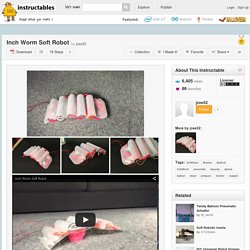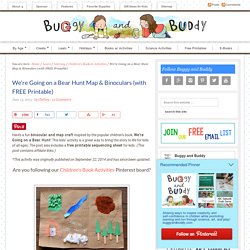

Inch Worm Soft Robot. (Time-lapsed videos above of Inch Worm Soft Robot) A few months back, I saw the videos of Matthew Borgatti’s soft robots (videos below) and was really captivated by them.

They inspired me to think about building a soft robot using pneumatic pressure for locomotion, but as a newbie to both Arduino and silicone casting, I decided to make a simplified version using more off-the-shelf, readily-available materials. This inch worm soft robot uses a party balloon, a hacked blood pressure monitor (for the pump, psi sensor, etc.) and some sheet silicone and vinyl. And an Arduino starter kit, of course! This robot is still connected to the Arduino UNO (and connected back to a laptop), but I eventually will miniaturize it and transfer it to a Pro-trinket and house it within the robot.
Basic Arduino Basic soldering Basic sewing Moderate-level craftiness (to assemble pieces) 1 blood pressure monitor (arm type) 1 balloon 1 sheet of vinyl (11” x 17”) 1 sheet of silicone (11" x 17") solid core electrical wires. Hydraulic Arm Challenge. Posted on March 13th, 2015 by Mary Lord TeachEngineering activity contributed by the Center for Engineering Educational Outreach, Tufts University.

Summary Teams of students in grades 6 to 8 follow the engineering design process to develop and build a mechanical arm that can lift and move an empty 12-ounce soda can using hydraulics for power. One group designs and builds the grasping hand, another team the lifting arm, and a third team the rotation base. The three groups must work to communicate effectively through written and verbal communication and sketches. Grade Level: 6 to 8 Time: 180 minutes (4 to 5 class periods) Engineering Connection Just like engineers, students in this activity work in teams and follow the steps of the engineering design process. Learning Objectives After this activity, students should be able to: Standards Next Generation Science Standards Common Core State Mathematics Standards International Technology and Engineering Educators Association K. Materials Suggested Timing.
Pneumatic machine. We're Going on a Bear Hunt Map & Binoculars (with FREE Printable) Here’s a fun binocular and map craft inspired by the popular children’s book, We’re Going on a Bear Hunt!

This kids’ activity is a great way to bring the story to life for kids of all ages. The post also includes a free printable sequencing sheet for kids. (This post contains affiliate links.) *This activity was originally published on September 22, 2014 and has since been updated. Are you following our Children’s Book Activities Pinterest board? The Preschool Book Club is back this week with creative activities for kids inspired by the story, We’re Going on a Bear Hunt! We’re Going on a Bear Hunt is one of my favorite books to read to children.
Making the Binoculars Start by decorating two empty cardboard tubes (we used toilet paper rolls). To create a space between the two tubes, cut a small piece of cardboard from an empty cardboard tube you aren’t using. Glue or tape each folded side to each cardboard tube to form your binoculars. Punch one hole into either side of your binoculars. 1. Toys from Trash. Lifting Jack Do it details.

Hydraulic Arm. Sticky Actuators. Making robots that move is not an easy task.

That’s why we leave that to trained engineers and other really smart people. But what if animating robots became as easy as printing an actuator, sticking it to an inanimate object, and using air to compress and decompress the actuator to spur movement? That’s exactly what they did with these Sticky Actuators, which opens up a whole new world of animating robots to everyone. A team comprised of Ryuma Niiyama from the University of Tokyo and several colleagues from MIT are behind the creation, which genuinely simplifies the way we can animate objects in real-life. Seriously. The Sticky Actuators are plastic pouches with an adhesive backing that you stick to the joints of the objects you want to set in motion. For their experiments, the team built a custom fabrication machine that simply moves a soldering iron over two sheets of thermoplastic in order to bond them, leaving pouches in the middle where air can enter.
Hydraulic Arm Challenge. Each TeachEngineering lesson or activity is correlated to one or more K-12 science, technology, engineering or math (STEM) educational standards.

All 100,000+ K-12 STEM standards covered in TeachEngineering are collected, maintained and packaged by the Achievement Standard Network (ASN), a project of JES & Co. (www.jesandco.org). In the ASN, standards are hierarchically structured: first by source; e.g., by state; within source by type; e.g., science or mathematics; within type by subtype, then by grade, etc.
Click on the standard groupings to explore this hierarchy as it applies to this document. Introduction/Motivation Have you ever seen a car lifted into the air at an auto repair place? Hydraulic systems use a liquid, usually oil, to transmit force. Assessment Activity Embedded Assessment: Administer the Arm Investigating Questions and Design Check List. © 2013 by Regents of the University of Colorado; original © 2006 Worcester Polytechnic Institute. Hydraulic rubric. Hydraulic robots. LIFTING JACK - ENGLISH - Hydraulic Jack! from Ice Cream Sticks.